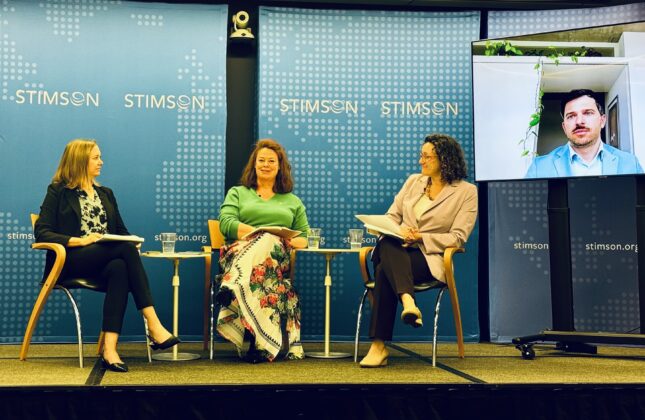-
Closing the Climate Finance Gap in Fragile States
November 11, 2025 By Madelyn MacMurrayA massive flood in Somalia killed hundreds of people, and displaced tens of thousands more. Yet the survivors faced a vexing prospect when they tried to return home: Al-Shabab had moved in.
Stephanie Speck, Head of Special Initiatives at the Green Climate Fund, observed at a recent Stimson Center event that Shabab’s new levies meant that residents could not to move back to farm their land.
This crisis in Somalia underscores why closing the finance gap in such highly vulnerable and conflict-affected states is essential. World Bank data reveals that fragile and conflict-affected countries receive just 65% of adaptation finance, while the balance goes to non-fragile countries.
Fragile and conflict-affected states receive just 5 dollars in adaptation finance per person every year, while non-fragile countries obtain 7 dollars per person. Worse still, this sum drops to 2 dollars in high-intensity conflict areas. Changing rainfall patterns, drought, flooding, and extreme heat cut through the threads of resilience that hold threatened communities together.
While civil society stakeholders engage in broad debates on the possibility of discussing climate, conflict, and peace, highly vulnerable and conflict-affected states find the question more immediate and pressing. Lindsey Paul-Jones, Senior Climate Change Specialist at the World Bank’s Global Risk Crisis Platform, underscored a key fact: Eight of the nations on the World Bank’s fragile and conflict situations list also can be found amongst its ranking of the ten most climate vulnerable countries.
Where institutions are weak or absent in regions of conflict and violence, the loss of resilience is compounded and can deepen instability. Closing the adaptation financing gap provides an opportunity not only to invest in adaptation, but to promote long-term development and stability.
Breaking Bottlenecks
Speck pointed to the urgency of acting. “You cannot talk about a climate emergency and then take three to four years to get funding into countries,” she said.
The Green Climate Fund has faced that criticism head-on. Over the last decade, she said that the GCF has revamped its grants review process, while explicitly directing its programming to close the financing gap in fragile states. The timeline for concept review has fallen from 18 months to six weeks, while results of funding proposals are now issued within nine months.
The results speak volumes. The GCF has increased its investments in climate adaptation in conflict-affected and fragile states to $2 billion, with $750 million programmed in 18 new fragile countries in just 12 months.
But speed alone isn’t enough. Trust building efforts that localize ultimate spending decisions to the government and local organizations must underpin these investments. Local stakeholders often feel constrained by donor-driven projects that do not align with their own priorities. Speck said that the GCF’s approach involves “setting down the foundations for countries to be in charge, and to chart their own territory.”
The GCF views institutional capacity as an essential foundation for successful projects. Thus, the fund provides 4 to 7 million dollars to every developing country for technical assistance required to identify and develop foundational infrastructure for subsequent climate finance and adaptation projects. The GCF also looks beyond the government to local organizations to identify key actors—such as NGOs, research organizations, and development banks—as partners. This allows project funds to flow directly into the budgets of the federal government, local governments, and local organizations to build on the ground capacity.
The result is that GCF climate finance aims to deliver three simultaneous outcomes: climate adaptation, a peace dividend, and an actual reduction in humanitarian spending over a five-to-ten-year period which enables countries to pursue their own prosperous economic pathways.
Yet getting finance where it’s needed requires more than structural reform. It also requires understanding what happens when interventions meet the reality on the ground. Three particular intervention windows provide opportunities for these impacts. Funding for natural resource management aid conflict prevention in 39 countries teetering on the edge of fragility. Post-conflict reconstruction aid can weave climate adaptation into programs. And humanitarian-to-development transitions build capacity that allows for an eventual shift from grants to entrepreneurial investments.
Keeping Good Intentions On Track
Not every intervention is a success. Unintended consequences are inevitable, especially in zones where conflict dynamics and territorial control create new challenges for interventions.
In Colombia, a GCF project which addressed natural resource conflict brought a peace which attracted internally displaced persons to communities. This tripled the pressure on the same resources that had been targeted, and thus restarted the cycle.
“We did not see that coming,” Speck admitted. Such cases serve as a reminder that conflict-sensitive programming isn’t rocket-science but requires guiding fundamentals.
Sustainable adaptation projects require both political economy analysis and the enlistment of local partners prior to investments. “In conflict zones, context matters, and there are no copy-paste solutions,” said Jones.
Contextual understanding of the drivers of instability in a particular area allows financing to target climate adaptation and address root causes of fragility. In Somalia, for instance, the World Bank supported capacity building for the nation’s financial management systems, which resulted in $700 million in on-budget donor support and $90 million from GCF. By contrast, a lack of capacity building in South Sudan has resulted in received zero on-budget support, and the GCF has struggled to reach $50 million in financing.
The goal is to build more adaptable projects. In Ethiopia, for instance, a climate adaptation project supported by the Dutch Ministry was launched before civil war broke out in that nation. Halfway through its implementation, the conflict escalated, and the project ceased for 18 months. A relaunch as “version 2.0” allowed organizers to rethink everything from a fragile-context perspective, including contingency measures and impact scenarios.
“That second project has been incredibly successful,” Jones said.
Drawing on lessons learned from humanitarian aid distribution can build in flexibility measures from the beginning. Ann Vaughan, Associate Vice President for CARE’s Resilient Futures Initiative said that when the Horn of Africa faced five consecutive failed harvests, its communities needed catastrophic drawdown clauses, instead of loan repayments that came due “the day after a flood has wiped out half the cropland.”
Local Engagement Can Close the Last Mile
Vaughan observed that only about 10% of climate finance reaches the local levels where impacts are actually felt by community members. “We have to change that,” she said.
Yet closing the last mile with financing is a pervasive challenge, especially since communities are at the front lines of disaster response and building resilience whether or not they do receive funding.
Organizations including CARE, the World Bank, and GCF have all signed onto locally-led adaptation principles. These eight basic guidelines center on making decisions at the local level, getting money to these communities, and listening to residents.
For the first time, GCF investments now go directly to local organizations. CARE’s Village Savings and Loans Association (VSLA) model illustrates the benefits of direct local investment. Since over 22 million people around the world are engaged in village savings and loan associations, the CARE model encourages women to get together to save and lend to one another to help build economic resilience. Community members are able to move beyond smallholder risk-adverse behavior, to invest in livestock or tools to be more resilient during periods of environmental disaster.
Every year communities lend approximately $1 billion to themselves in the VSLA program. “This is real money that communities are investing in themselves,” Vaughan said.
A partnership with WWF also allows organizations to use the VSLA model to set aside money to launch green businesses. Communities now work on agroforestry and start microenterprises tp protect and rebuild the environment, deal with the effects of climate change, and create more resilient communities. “There’s a model to be able to leverage that type of funding,” Vaughan added.
The VSLA model also helps fragile states such as Yemen, where Vaughn says it can “untap and bring together social cohesion that comes when you lend with your neighbor and share together.”
Climate finance to fragile countries has increased eightfold between 2016-2020 at the World Bank alone. But the path forward has not been easy. “We have lost a lot of time in not being clear about our numbers, in not being clear about the transactional benefits,” Speck said.
The moral case does matter, but it’s insufficient in itself. Climate finance in fragile states also serves as risk reduction that will help prevent 65 additional days of 33 degree celsius heat that will decimate African and Middle Eastern Agriculture. It’s also a strategic opportunity because green-based labor forces and renewable energy are fast growing global trends. “It is about securing the prosperity and peace of countries,” Speck concluded.
Can the architecture of financing that connects climate and conflict keep pace? “We have to do so much more with every dollar,” said Vaughn. “But that’s actually an opportunity.”
Madelyn MacMurray is a Research Assistant in the Stimson Center’s Environmental Security Program.
 A Publication of the Stimson Center.
A Publication of the Stimson Center.









